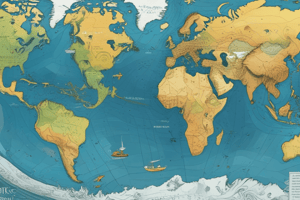Podcast
Questions and Answers
What are tides?
What are tides?
The daily rise and fall of Earth's waters on its coastlines.
Explain high tides.
Explain high tides.
High tide occurs as the tide comes in, and the level of water on the beach rises gradually, reaching its highest point.
Explain low tides.
Explain low tides.
Low tide occurs when the tide goes out back to the sea, reaching its lowest point.
What causes tides?
What causes tides?
What force causes tides to occur on Earth's surface?
What force causes tides to occur on Earth's surface?
How many high tides and low tides occur in a day?
How many high tides and low tides occur in a day?
What influences the monthly tide cycle?
What influences the monthly tide cycle?
What is a spring tide?
What is a spring tide?
What is a neap tide?
What is a neap tide?
How can tides be used as an energy source?
How can tides be used as an energy source?
Why doesn't the sun affect tides more than the moon does?
Why doesn't the sun affect tides more than the moon does?
What are the positions of the sun, moon, and Earth during spring tides?
What are the positions of the sun, moon, and Earth during spring tides?
What are the positions of the sun, moon, and Earth during neap tides?
What are the positions of the sun, moon, and Earth during neap tides?
Flashcards are hidden until you start studying
Study Notes
Tides Overview
- Tides refer to the daily rise and fall of sea levels along coastlines.
High Tides
- Occur as the tide comes in, causing water levels to rise gradually until reaching the highest point.
Low Tides
- Occur as the tide recedes, resulting in water levels dropping until reaching the lowest point.
Causes of Tides
- Tides result from the gravitational interaction between Earth, the moon, and the sun.
Gravitational Forces
- The moon's gravitational pull creates tidal bulges on Earth, leading to high tides in regions closest and farthest from the moon, while low tides occur in between these bulges.
Tide Frequency
- Each day experiences two high tides and two low tides, occurring over a 25-hour period.
Monthly Tide Cycle
- The positions of Earth, the moon, and the sun change throughout the month, influencing the heights of tides.
Spring Tides
- Occur twice a month during new and full moons when the sun and moon align, resulting in the maximum difference between high and low tides.
Neap Tides
- Happen during the first and third quarters of the moon, as the sun and moon exert gravitational forces at right angles, resulting in minimal differences between high and low tides.
Tidal Energy
- The movement of water during high and low tides represents a potential energy source. Tidal power plants harness this energy as tides advance and retreat.
Influence of the Sun and Moon
- Although both the sun and moon affect tides, the moon has a greater impact due to its proximity to Earth.
Spring Tide Geometry
- Occurs when the sun, moon, and Earth align with Earth in between, causing the greatest gravitational pull on Earth's waters.
Neap Tide Geometry
- Takes place when the sun, moon, and Earth form a right angle, resulting in opposing gravitational forces on Earth's waters, leading to lower tide differences.
Studying That Suits You
Use AI to generate personalized quizzes and flashcards to suit your learning preferences.




